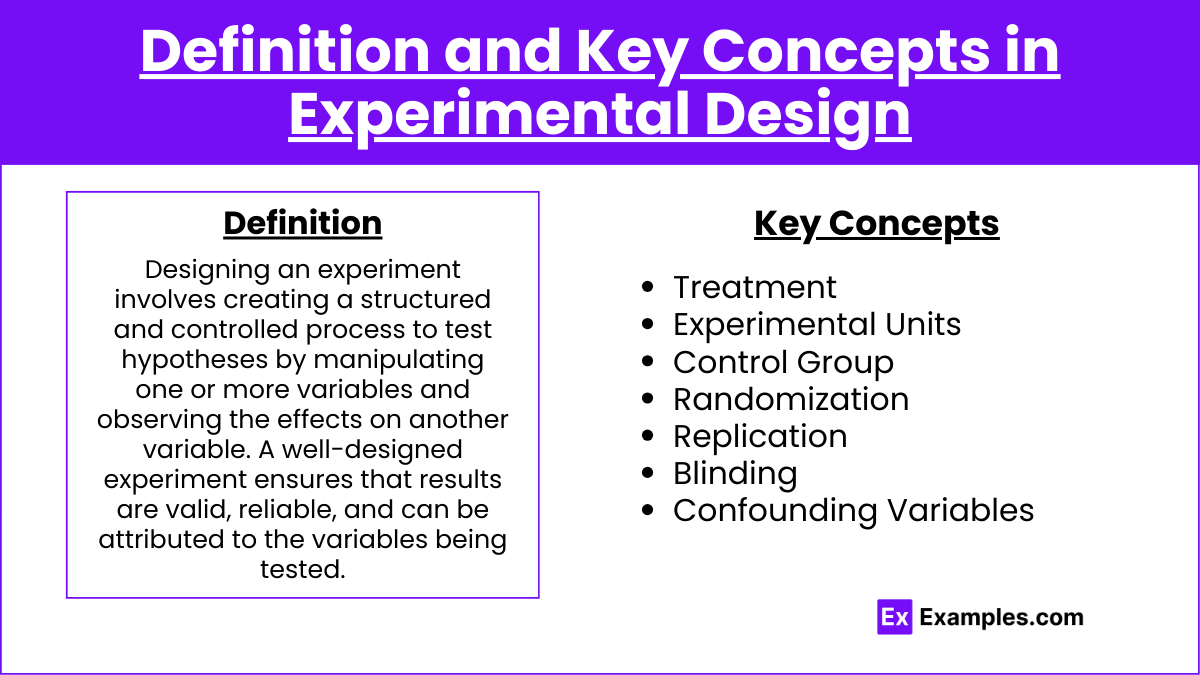In AP Statistics, designing an experiment is a vital skill for testing hypotheses and understanding cause-and-effect relationships. This process involves creating a controlled environment to manipulate one or more variables and observing their effects on another variable. Key components include randomization, control groups, blinding, and replication. By mastering these elements, students can ensure their results are valid, reliable, and free from bias, enabling them to draw accurate conclusions and make informed decisions based on their experimental data.
Learning Objectives
By studying designing an experiment, you will learn how to create structured and controlled procedures to test hypotheses in AP Statistics. You will understand key components such as randomization, control groups, blinding, and replication. This knowledge will help you minimize bias, ensure validity and reliability, and accurately determine cause-and-effect relationships. Mastering these skills will enable you to conduct robust experiments and make informed conclusions based on my data analysis.
Definition

Designing an experiment involves creating a structured and controlled process to test hypotheses by manipulating one or more variables and observing the effects on another variable. A well-designed experiment ensures that results are valid, reliable, and can be attributed to the variables being tested.
Key Concepts in Experimental Design
- Treatment: The condition or intervention applied to experimental units.
- Experimental Units: The smallest division of the experimental subjects that receives different treatments.
- Control Group: A group that does not receive the treatment, used for comparison.
- Randomization: Randomly assigning subjects to treatment groups to reduce bias.
- Replication: Repeating the experiment to ensure consistency and reliability of results.
- Blinding: Keeping subjects and/or experimenters unaware of the treatment assignments to prevent bias.
- Confounding Variables: External factors that can affect the outcome, making it difficult to isolate the effect of the treatment.
Steps in Designing an Experiment

- Define the Research Question: Clearly state what you want to investigate.
- Identify Variables:
- Independent Variable: The variable you manipulate.
- Dependent Variable: The variable you measure.
- Select the Experimental Units: Choose the subjects or items to be tested.
- Choose a Design: Decide on the type of experimental design (e.g., completely randomized, randomized block, matched pairs).
- Randomize: Randomly assign subjects to different treatment groups to ensure each group is comparable.
- Implement Controls: Use control groups and control for confounding variables.
- Apply Treatments: Administer the treatments to the experimental units.
- Measure the Outcomes: Collect and analyze the data on the dependent variable.
- Replicate: Repeat the experiment to verify the results.
Types of Experimental Designs

- Completely Randomized Design: Subjects are randomly assigned to all treatments.
- Randomized Block Design: Subjects are divided into blocks based on a characteristic, and then randomly assigned to treatments within each block.
- Matched Pairs Design: Subjects are paired based on a characteristic, and each pair is split into different treatments.
Examples
Example 1: Completely Randomized Design
Research Question: Does a new fertilizer increase crop yield?
Design:
- Independent Variable: Type of fertilizer (new vs. standard).
- Dependent Variable: Crop yield.
- Procedure: Randomly assign 100 plants to receive either the new or standard fertilizer and measure their yield after a growing season.
Example 2: Randomized Block Design
Research Question: Does exercise improve mental health among different age groups?
Design:
- Independent Variable: Exercise program (with exercise vs. without exercise).
- Dependent Variable: Mental health scores.
- Procedure: Divide participants into age groups (e.g., 20-30, 31-40, 41-50), then randomly assign within each group to either the exercise program or no exercise.
Example 3: Matched Pairs Design
Research Question: Does a new drug lower blood pressure more effectively than the current drug?
Design:
- Independent Variable: Type of drug (new vs. current).
- Dependent Variable: Blood pressure levels.
- Procedure: Pair participants based on similar characteristics (e.g., age, weight) and randomly assign one from each pair to the new drug and the other to the current drug.
Example 4: Blinding
Research Question: Does a new teaching method improve student performance?
Design:
- Independent Variable: Teaching method (new vs. traditional).
- Dependent Variable: Test scores.
- Procedure: Randomly assign classes to use the new or traditional method and keep students and teachers unaware of the assignment to prevent bias.
Example 5: Control for Confounding Variables
Research Question: Does caffeine improve concentration?
Design:
- Independent Variable: Caffeine intake (with vs. without caffeine).
- Dependent Variable: Concentration test scores.
- Procedure: Randomly assign participants to either receive caffeine or a placebo and control for factors like sleep and diet that could affect concentration.
Multiple Choice Questions
MCQ 1
What is the primary purpose of randomization in an experiment?
- To simplify the design process.
- To ensure that the results are significant.
- To reduce bias by evenly distributing confounding variables.
- To increase the sample size.
Answer: 3. To reduce bias by evenly distributing confounding variables.
Explanation: Randomization helps ensure that confounding variables are evenly distributed across treatment groups, reducing bias.
MCQ 2
In a randomized block design, why are subjects divided into blocks?
- To increase the sample size.
- To ensure that each block receives all treatments.
- To control for variables that could affect the outcome.
- To simplify data analysis.
Answer: 3. To control for variables that could affect the outcome.
Explanation: Blocking helps control for variables that might influence the dependent variable, ensuring more accurate results.
MCQ 3
What is a control group used for in an experiment?
- To receive the same treatment as the experimental group.
- To eliminate the need for randomization.
- To provide a baseline for comparing the effects of the treatment.
- To ensure every variable is tested.
Answer: 3. To provide a baseline for comparing the effects of the treatment.
Explanation: The control group does not receive the treatment, providing a baseline to compare the experimental group’s results.


